This post contains affiliate links. We may get paid an affiliate commission if you buy something or take an action after clicking one of the links on this web page.
Last Updated: August 20, 2019
In the course of reviewing hundreds of knives, occasionally something comes so far from out field that you feel compelled to examine it. If anything, for posterity. I felt that way when Vlad Kovalov of RussianKnives.com approached me about the Rosarms Kisten.
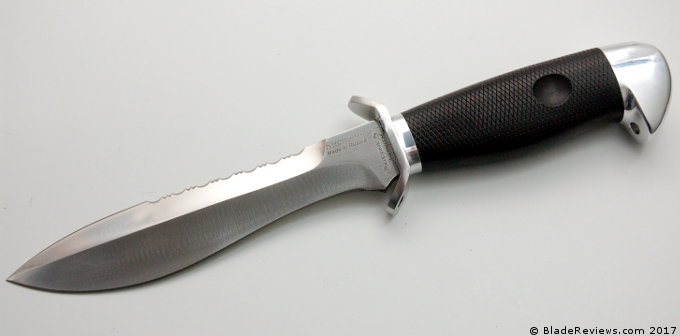
This is a Russian fighting knife designed by Alexander Kisten. Alexander Kisten is a 1984 graduate from the Ryazan Airborne Command School. After graduating he went on to serve in a distinguished military career with the Russian army. In 1995, he retired from military service and began working in the security services of commercial companies. Since 2003, he has lived in Moscow, teaching techniques of knife fighting for the special units of various government agencies.
In 2016 Alexander teamed up with Rosarms to develop the Kisten. This is a knife so far outside my comfort zone that I won’t even pretend to call this a review. I have absolutely zero martial arts training, and no practical knowledge of using a knife for combat or self defense. I probably should have passed the Kisten on to Chad McBroom for a true evaluation, but when the knife arrived I was intrigued. “Sure, I can write an article on this,” I thought as I thumbed the sharpened spine of the blade.
General Dimensions and Blade Details
The Kisten has an overall length of 11″, a 6.25″ blade. This knife is made in Russia. I am not sure of the exact weight, but it feels light for its size and has a nice balance to it, with the center of gravity being right behind the guard.
This knife is a pure combat / fighting knife. While I suppose nothing is preventing you from using it at a campsite, it’s double edged, so it could be potentially illegal to bring to a camp site. And lets face it, Alexander Kisten isn’t designing kitchen knives. A man with this kind of martial arts pedigree is building a purpose built tool.
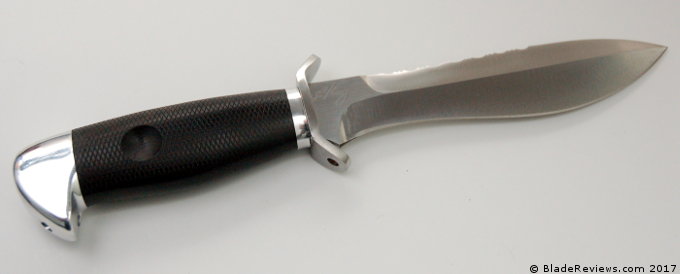
The blade of the Kisten is a dramatic modified drop point. I think the most interesting aspect of the blade is that it is double edged, and the top edge features a row of serrations. These are fully sharpened serrations. The sweeping belly and ample recurve are likely the next most noticed aspect of the blade. The deep belly may provide a little extra weight and geometry for chopping, but my guess is it’s primary advantage is for trapping and cutting flesh.
The blade is double hollow ground and features a bright satin finish. It makes for a dramatic knife. The grinds are all done beautifully. The knife gets thin behind the edges. And the edges themselves are even and neatly ground.
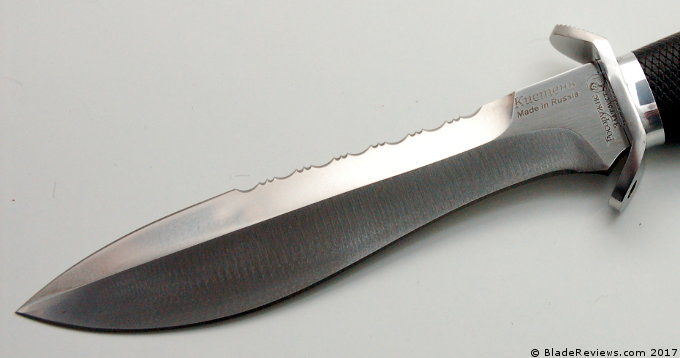
The blade of the Kisten is made from EL-107 stainless steel. I have not encountered this steel before, but ZKnives has it covered in his steel chart, and even he doesn’t have much to say about it beyond it being “heat resistant valve steel” that is “used by several Russian knifemakers”. I can’t say that I have used this knife a whole lot. If I do I’ll update this section of the article.
Handle and Ergonomics
Like the blade, the handle of the Kisten is also unique. For starters you can completely disassemble the knife with a flathead screwdriver. This is thanks to the stick tang construction. I haven’t tried this, but it’s interesting to see. The choice of materials is also unique. you have an aluminum forward guard, a hornbeam wood handle segment, and a polished aluminum pommel.
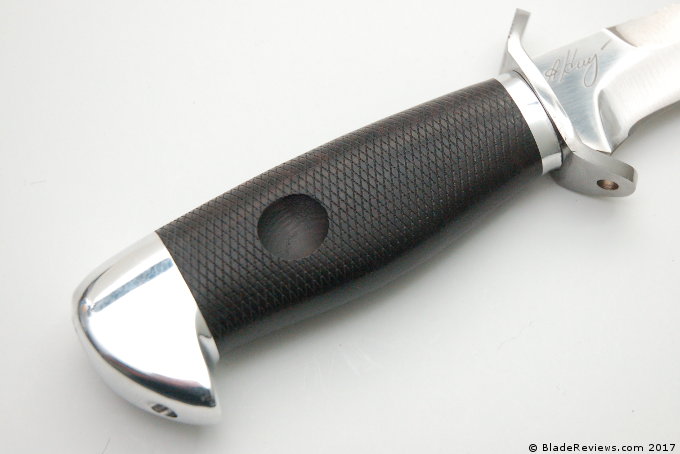
Hornbeam wood is not a wood I have experience with, but according to Rosarms hornbeam wood was used on the classic Russian NR-40 WWII Scout/Recon knife, which is essentially a Russian Ka-Bar USMC knife. Hornbeam is a dark brown wood with a tight grain.
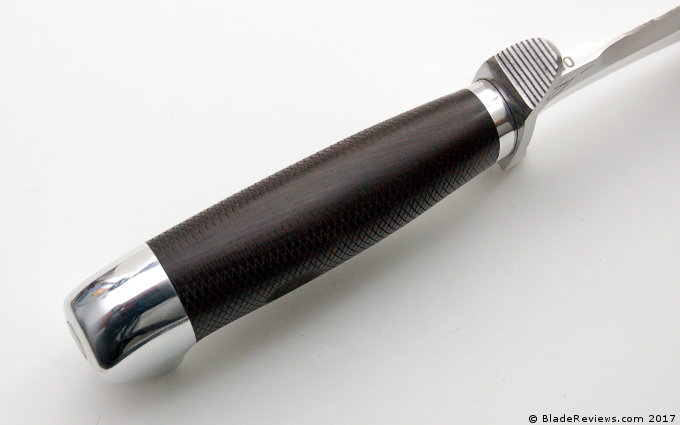
The handle has been finished neatly with a diamond pattern and 2 deep dimples. I suspect the dimples are for indexing your fingers on the handle. Adding to the ergonomics is the flared pommel / end cap, and flared forward guards. The top guard doubles as a thumb ramp and is lightly jimped. Rounding things out are 2 lanyard holes for extra security. The end result is a comfortable handle that fills the hande and offers good traction.
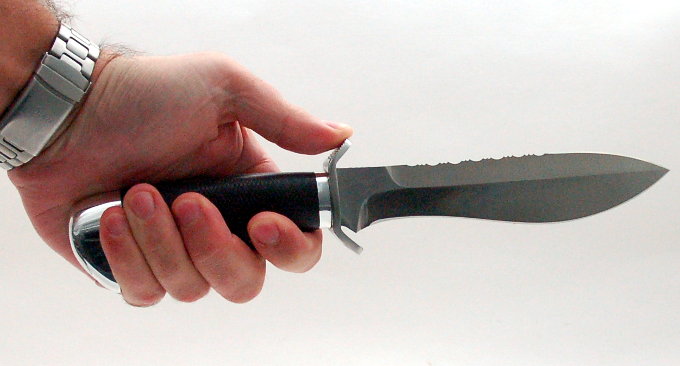
I won’t pretend to know what I am talking about when it comes to the ergonomics from a self defense standpoint, but the knife feels fast and light in hand, and I can’t see how it would slip out easily.
Sheath
The Kisten comes wit ha pancake style ABS Thermoplastic sheath. It’s like a kydex sheath, but lighter weight plastic. In some ways it reminds me of the lightweight sheathes that come with Fallkniven knives. Although it feels a little less impressive than a true kydex sheath, this is still a secure and functional sheath.
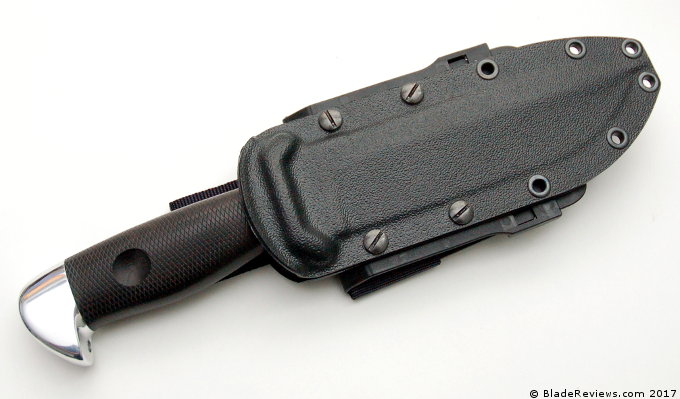
It is MOLLE compatible and comes with MOLLE clips and a nylon belt loop. There is no rattle, a drain hole, and extra eyelets so you can configure the sheath for horizontal or vertical carry. Removing the knife from the sheath requires you to place your thumb on the sheath and levering the blade out. It’s secure. My preference would be for a true kydex sheath with a heavier belt loop, something like my Junglas, but this sheath is fully functional.
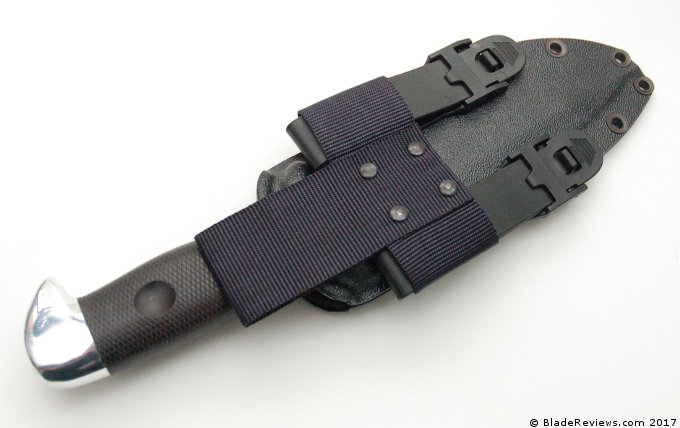
Kisten Rosarms – Final Thoughts
The Kisten is a dedicated self defense tool for martial artists and enthusiasts of fighting knives. This is not a review, but hopefully this has at least been a decent introduction to the knife. Although I don’t want to comment much on the practical merits of the knife, obviously I would not recommend this for casual knife fans or people seeking an outdoor utility knife.
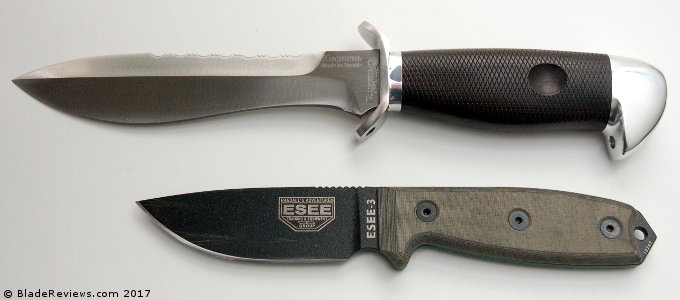
However, if you are a fan of tactical fixed blade knives or a fan of Alexander Kisten, then I think you will find this ROSarms Kisten to be nicely made and fully functional. The blade is beautifully ground and the knife has been made to tight tolerances. The sheath is equally well made. The Kisten is not or everyone, but I think those who like this knife on paper will enjoy it in person as well. I also think the $140 price tag is fair for this unique knife. The materials are nice and the craftsmanship is evident throughout the Kisten.
If you want to learn more about the knife I recommend checking it out at the RussianKnives.com.
Very interesting. A number of design considerations are expressed in the knife. Compare the blade shape to the Roman sword. Then compare the vertical pieces of metal facing forward (I call them “stops”) and the dual blade to the Glock knife. Also compare the relative lengths. To all appearances, it is a special application knife and a bit long to carry on a day-to-day basis. Then compare the knife to an Ontario TFI which is ergonomically designed with a decent sheath and has more general applications potential.
Thank you, bc. Absolutely, this is a special application knife. Purpose built to Mr. Kisten’s specifications. By way of comparison the Ontario TFI is going to be a much better camp / utility knife.
Dan
Hey Dan! Do you have any thoughts on the Gerber GDC Tech Skin? It’s a knife that I’ve been thinking of picking up, and I was wondering what your opinion on it is.
Thanks, Ryan
Hey Ryan,
I have not heard of the Tech Skin until now. Reading through the specs it looks like a decent little knife. For around $25 I’d say if the design intrigues you check it out and let me know what you think.
Dan
For that price range, is 7Cr17 a good steel?
Ryan, I’d say 7Cr17 is par for the course for a ~$25 knife. Usually you see something like 8Cr13Mov, or AUS8. 7Cr17MoV is similar to 8Cr13Mov. Although some would argue that 8Cr13MoV is superior to 7Cr17MoV, I am not sure if I would be able to tell the difference between the two steels. They are both lower end steels used on less expensive knives. I would not have particularly high expectations for the Tech Skin, but for $25 or so it’s not a huge investment.
Dan
Not really, TBH. If Kershaw can make knives for $20 with 8Cr13MoV, what is the extra money on the Gerber getting you that’s worth a compromise in performance when you’re already scraping the bottom of steel performance in the first place with 8Cr?
“The handle has been finished neatly with a diamond pattern and 2 deep dimples. I suspect the dimples are for indexing your fingers on the handle.”
A while ago, when I was researching Spyderco’s Temperance 2, I read that the first Temperance had divots in the handle to facilitate grip changes. I’m not an expert but I thought of that when I read your review.
Noel,
That is an interesting observation. I would not be surprised if that is the purpose. Thanks for bringing that up.
Dan